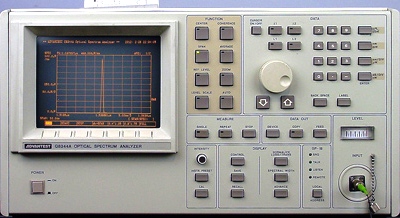
|
|
The Advantest Q8344A is an optical spectrum analyzer with a wide wavelength range from 0.35 to 1.75 um. The usage of a Fourier spectrum system using a Michelson interferometer makes it possible to analyze coherence that cannot be obtained by the dispersing spectrum systems using monochromators. It exhibits its capabilities for evaluation of laser diodes for CDs and video disks. The built-in He-Ne laser used as the reference wavelength realizes a wavelength accuracy of ± 0.1 nm (1.3 um), ensuring a long-term measurement stability even without wavelength calibration. The Q8344A provides a maximum wavelength resolution of 0.05 nm (at 0.85 um), accommodating measurements of laser diodes with narrow mode intervals. The measurement speed is approx. 1.5 seconds (at 0.4 to 1.05 um and 0.8 to 1. 75 um) regardless of the analysis span, allowing it to be used as a system component. With the versatile display, analysis and processing functions , the Q8344A can be used for characteristic measurement applications for diverse components ranging from photo emitting elements such as laser diodes and LEDs to optical components such as optical fibers and filters . Specifications. Measurement range: 0.35 to 1.75 um. Max. resolution: Approx. 0.05 nm (at 0.85 um), 0.1 nm (at 1.31 um). Accuracy: ± 0.1 nm (The wavelength Indicated is the value in vacuum.). Span: 0.1 to 140 nm/DIV. Measurement range (input sensistivity): -70 to +10 dBm (0.7 to 1.6 um). Level Accuracy: ± 2.0 dB or less (at a wavelength of 0.85um or 1.31 um). Linearity: ±1.0 dB/ 25 dB or less, ±0.5 dB/ 10 dB or less. Scale: 0.2, 0.5, 1.0, 2.0, 5.0, 10.0 dB/DIVand LINEAR. Measurement time: 1.5 seconds or less (SINGLE mode, AVG: 1, Trigger to data output). Options. Option 01, Built-in printer. Option 10, 200 um fiber input.
|